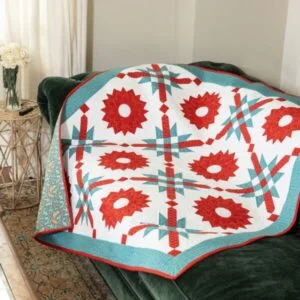Creating a Hexagon Flower Quilt Block can be a fun and rewarding experience for any quilter, whether you’re a beginner or experienced. This Hexagon Flower Quilt Block Tutorial will guide you step-by-step through the process, making it simple and enjoyable to add a unique and beautiful design to your quilt projects.
With its stunning geometry and floral-inspired shape, the Hexagon Flower Quilt Block has become a popular choice for many quilt enthusiasts looking to create something special.
In this tutorial, we’ll cover everything you need to know about making a Hexagon Flower Quilt Block from start to finish. Whether you’re assembling blocks for a full quilt or just adding a few flowers to your project, this guide will provide all the details you need. Be sure to follow along carefully, and feel free to revisit the steps whenever necessary.

By the end of this Hexagon Flower Quilt Block Tutorial, you will have a beautiful and versatile block to use in any quilt design. This block pattern adds texture, depth, and visual interest, making it a favorite among quilters worldwide. Now, let’s dive into the details and start crafting your very own Hexagon Flower Quilt Block!
1. What is a Hexagon Flower Quilt Block?
The Hexagon Flower Quilt Block is a classic quilt block design that consists of hexagonal pieces arranged in a floral pattern. Each hexagon is pieced together to form a central flower, which can be repeated to create a larger quilt top. The symmetry and intricate design make this block both captivating and timeless.
- The hexagon shape is unique in the quilting world, providing six sides that create a different visual appeal compared to traditional square blocks.
- This flower block typically consists of a central hexagon, surrounded by six hexagons, resembling petals of a flower.
- Quilters can experiment with fabric color choices to create vibrant flowers or more subtle designs, depending on the style they want to achieve.
- While it might seem challenging, the process is quite simple once you understand the basics of working with hexagons.
- Hexagon templates are readily available, or you can make your own by cutting hexagon shapes from fabric using a rotary cutter or scissors.
- Quilters often use the English Paper Piecing method to assemble Hexagon Flower Quilt Blocks, ensuring precision and neat seams.
2. Materials Needed for a Hexagon Flower Quilt Block
Before starting, gather all the necessary materials to create a successful Hexagon Flower Quilt Block. Proper preparation will ensure your quilting experience is smooth and enjoyable.
- First, you will need fabric in different colors for the hexagons, especially if you plan to create a flower-like design.
- A rotary cutter and cutting mat are essential for cutting precise hexagon shapes. If you don’t have a rotary cutter, sharp fabric scissors will work too.
- Hexagon templates are critical for cutting fabric accurately. You can find templates in various sizes, or you can print them out and cut your own.
- Thread that matches your fabric or a neutral thread will be useful for sewing the pieces together.
- Pins are helpful to keep the fabric pieces in place, ensuring accuracy as you sew.
- A sewing machine is not required for English Paper Piecing, but it can be used if you prefer machine sewing your hexagons.
Once you have all your materials, it’s time to start cutting your hexagons and arranging them into a Hexagon Flower Quilt Block.
3. How to Assemble a Hexagon Flower Quilt Block
Now that you have all your materials, it’s time to start assembling your Hexagon Flower Quilt Block. Follow these steps carefully for a flawless result.
- Begin by cutting out your hexagon shapes from fabric, using either your template or a pre-made hexagon ruler. Ensure that each hexagon is of uniform size for the best results.
- Arrange your hexagons in a flower pattern, with one hexagon in the center and six surrounding it to create petals.
- Use pins to hold the fabric pieces in place, especially if you’re using the English Paper Piecing method. This helps maintain the alignment of the hexagons.
- Start by sewing the hexagons together. For English Paper Piecing, sew each hexagon by hand, carefully stitching along the edges.
- As you join the hexagons, ensure the seams are neat and precise, as this will ensure the hexagons lay flat when pressed.
- Once all hexagons are joined, press the seams with an iron to ensure the block remains flat and the edges are crisp.
4. Adding the Hexagon Flower Quilt Block to a Larger Quilt
Once your Hexagon Flower Quilt Block is assembled, you may want to add it to a larger quilt. Here’s how you can incorporate your block into a full quilt project.
- Start by making multiple Hexagon Flower Quilt Blocks. Each block can be arranged in a repeating pattern or scattered throughout your quilt design.
- You may choose to alternate the Hexagon Flower Quilt Blocks with solid fabric blocks to break up the design and create a more modern look.
- Ensure all blocks are of equal size before joining them into the larger quilt top. This helps prevent uneven seams and distortion.
- Once you’ve arranged your blocks, sew them together using a quarter-inch seam allowance, being careful to match the corners and edges.
- Press all seams flat once you’ve joined the blocks together. This ensures your quilt top remains smooth and professional-looking.
- After assembling your quilt top, add the batting and backing fabric to complete the quilt.
Frequently Asked Questions (FAQ)
What size should my hexagons be?
Hexagons can vary in size depending on your quilt’s design. Standard hexagons range from 1 inch to 2 inches in diameter, but you can adjust the size based on your project’s needs.
Do I need to use a specific fabric for this block?
No, you can use any fabric for the Hexagon Flower Quilt Block. Quilters often use cotton fabric, but feel free to experiment with different textures and patterns.
Can I sew hexagons by machine?
Yes, you can sew hexagons using a sewing machine. However, many quilters prefer the English Paper Piecing method for better accuracy and precision.
How do I avoid puckering when sewing hexagons?
Ensure you’re using even, consistent stitches when sewing hexagons together. Pressing the seams after each step also helps keep the fabric flat and prevents puckering.
Can I make a quilt using only Hexagon Flower Quilt Blocks?
Absolutely! Many quilters create entire quilts using just Hexagon Flower Quilt Blocks, making for a cohesive and beautiful floral design.
How do I finish the edges of a quilt with hexagons?
To finish the edges, you can trim the sides of the quilt top to create a straight edge, or add borders around the hexagons for a clean finish.
Join our VIP broadcast list and gain access to exclusive patterns, all for free. As a VIP member, you’ll receive the best patterns daily, delivered directly to your device. ✨📱 It’s a unique opportunity to stay up-to-date with the latest trends and designs, curated just for you. Don’t miss out on enhancing your projects and discovering new inspirations with the best patterns every day! 🎨🔝
Conclusion
In this Hexagon Flower Quilt Block Tutorial, we’ve covered everything you need to know about creating this stunning block, from the materials you need to the assembly process. By following these steps, you’ll be able to add this versatile and beautiful block to any quilt design, enhancing its appeal with intricate floral patterns. Now it’s your turn to try it!
Please share your thoughts and suggestions in the comments. We’d love to hear about your experience creating the Hexagon Flower Quilt Block, and any tips or variations you might have tried!



